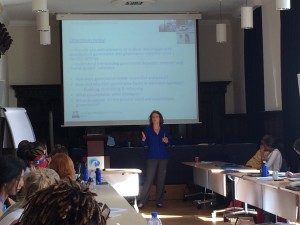Catarina Inverso, Brazil
How, and from where, do systems of governance emerge in a post-war context?Is a top-down or a bottom-up approach better  equipped to establish a new government? What about hybrid approaches of governance?
equipped to establish a new government? What about hybrid approaches of governance?
Dr. Gemma van der Haar exposed key concepts and discourses stemming from social science in relation to processes of state formation, systems of governance and asked questions, which challenged our varied understandings and opinions about the topic. Establishing governance in transitions is by no means a clear-cut process, as the lecture demonstrated. From an understanding that ‘governance is bigger than the state’, Dr. van der Haar encouraged us to enquire about this idea, touching on the dominant good governance discourse, and to consider non-state forms of governance. For aspiring peacemakers, trying to understand what conflict does to institutions and governance is fundamental if we are to develop knowledge and skills to act in post-conflict transitions. Going a step further, we come to realize that the disruptive nature of war establishes systems of local governance that sometimes challenges top-down approaches of institutional building.
From the perspective of the international community involved, the need to build physical infrastructure and to establish multi-party elections is a common pre-condition for a legitimate government. On the other hand, the perspective from ‘below’ where the society level is concerned, systems of power, profit, and protection develop at the local level outside of the formal realm of institutional governance. This is a context in which post-conflict societies find themselves organized within states, where there might be a ‘governance without a government’ situation. This thought-provoking concept prompts questions surrounding issues of legitimacy, accountability, the delivery of public goods and many other aspects involving the functioning of the state. This makes one rethink what is needed in a transitional period. Established systems of local governance may not be seen to be legitimate simply because they do not conform to the norms of a stable society.
 By presenting two short videos related to how governance is created through a rather romanticised idea of democratic decision-making, and the reality of a scenario where popular protest exerts its right to demand government accountability, the state-society relationship proves to be more complicated in reality than how it is presented to us. The lecture was an attempt to cover a wide range of subjects in the governance literature, and despite a very engaging environment, much remains to be discussed. There isn’t however, straight answers to the many questions we faced today, and that indicates just how complex real life situations are making our jobs as peacemakers all the more challenging. How do we make the right choices in post-conflict situations, when parallel forms of governance are in place, and we have to consider a new dynamic where the multitude of actors is increased? The ability to address different interests and needs in societies is to me the key dilemma in transitioning process of institutional building. But to assume that we can have an answer on what can be done and how can we guarantee a successful system of governance that is sustainable and accountable to a plural society, would be too ambitious when there is no ‘one-size-fits-all’. We are instead to acknowledge a context-specific scenario, where perhaps hybrid political orders could be upheld as new forms of governance to address different grievances at different levels of society, although even such approaches remains problematic.
By presenting two short videos related to how governance is created through a rather romanticised idea of democratic decision-making, and the reality of a scenario where popular protest exerts its right to demand government accountability, the state-society relationship proves to be more complicated in reality than how it is presented to us. The lecture was an attempt to cover a wide range of subjects in the governance literature, and despite a very engaging environment, much remains to be discussed. There isn’t however, straight answers to the many questions we faced today, and that indicates just how complex real life situations are making our jobs as peacemakers all the more challenging. How do we make the right choices in post-conflict situations, when parallel forms of governance are in place, and we have to consider a new dynamic where the multitude of actors is increased? The ability to address different interests and needs in societies is to me the key dilemma in transitioning process of institutional building. But to assume that we can have an answer on what can be done and how can we guarantee a successful system of governance that is sustainable and accountable to a plural society, would be too ambitious when there is no ‘one-size-fits-all’. We are instead to acknowledge a context-specific scenario, where perhaps hybrid political orders could be upheld as new forms of governance to address different grievances at different levels of society, although even such approaches remains problematic.
Overall, the lecture gave us the chance to engage in deep discussion and push our mind to find solutions that are simply not easy to find.

